MAGNETIC FIELD GROWTH IN GALACTIC DISCS OF VARIOUS THICKNESS
Evgeny Mikhailov, Tatiana Khasaeva and Maria Frolova
Publication
BOOK OF ABSTRACTS: XIV Serbian-Bulgarian Astronomical Conference, Page 25, https://doi.org/10.69646/14sbac22a
BOOK OF ABSTRACTS: XIV Serbian-Bulgarian Astronomical Conference, 23 - 27 September, 2024, Vrnjačka Banja, Serbia. Editors: Milan S. Dimitrijević, Evgeni Semkov, Zoran Simić, Goran Damljanović, Momchil Dechev
Published: 17. 11. 2024.
Abstract
Now it is strongly believed that a large variety of galaxies have large-scale magnetic field of several μG [1]. Observational studies of magnetic fields are usually obtained byG [1]. Observational studies of magnetic fields are usually obtained by Faraday rotation of the plane of polarization of radiowaves. From a theoretical point of view, the generation of regular magnetic field structures is explained using the mean field dynamo mechanism. It is described by Steenbeck – Krause - Rädler equation which is a result of averaging equations of magnetohydrodynamics. It is quite difficult to be solved exactly, so different specific approximations gave been developed. As for inner parts of the Milky Way and some similar galaxies the thin disc dynamo model has been used [2]. At the same time, if we study the magnetic field in the case of the outer regions, where disc becomes thicker, as well as in the case of galaxies with large thickness, this model cannot properly describe the structure of the field. To clarify the results, we can use the thickness parameter in the equations as a changing value [3]. However, it is much more effective to construct a model that takes into account the z-structure of the field, as well as the vertical flows of the medium transporting the frozen-in field. We developed ideas about the dynamo action in thick disks, and compared the results obtained by different approximations [4]. It is shown that as the thickness of the galactic disk increases, field generation in it becomes more difficult. However, even in such galaxies the field can be generated by magnetorotational instability [5].
References:
[1] Beck, R., Brandenburg, A., Moss, D. et al.: 1996, Ann.Rev.Astron.Astrophys., 34, 155
[2] Moss, D.: 1995, MNRAS, 275, 191
[3] Mikhailov, E., Kasparova, A., Moss, D. et al.: 2014, Astron. Astrophys., 568, A66
[4] Mikhailov, E., Pashentseva, M.: 2023, Mathematics, 11, 3106
[5] Mikhailov, E., Khasaeva, T.: 2024, Mathematics, 12, 760




